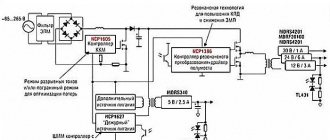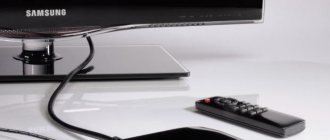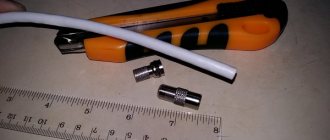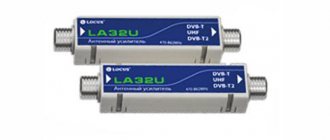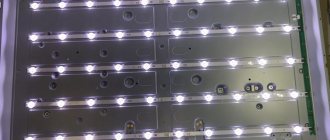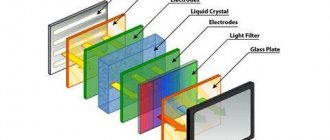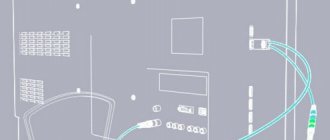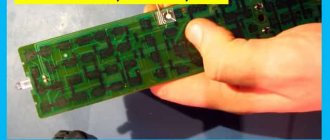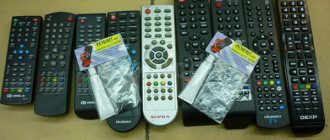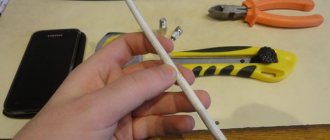Despite the variety of brands and models, TVs for service center technicians and engineers remain simple and predictable to repair; timely technical support from the manufacturer with components, modules, documentation and software greatly facilitates and simplifies diagnostics and repairs, but is focused on replacing entire modules and repairs. Manufacturers do not support the replacement of elements in modules, and service documentation has not been completed with circuit diagrams for a long time.
Since the early nineties of the last century, craftsmen have accumulated a wealth of general experience in repairs, which is discussed and stored on the Internet in numerous conferences and blogs of repairmen. Typical defects of some models have sometimes caused controversy and deserve special attention. In this series of articles, we plan to consider the most common faults encountered in repair practice of popular brands and models of LCD and CRT TVs from 2000.
Kinescope device
The role of the main part in an old-style television receiver is performed by a cathode ray tube (CRT), called a kinescope. The principle of its operation is based on electronic emission. The mechanism of such a tube includes:
- electron guns;
- focusing and deflecting coils;
- anode terminal;
- shadow mask to separate color images;
- a layer of phosphor with different luminescence zones.
The kinescope, made of glass, is coated inside with a discrete phosphor. The coating consists of triads - a set of three points, each of which corresponds to red, blue and green.
A point included in the triad receives a beam emanating from a specific electron gun and begins to emit light of varying intensities. To achieve the required shade, special metal gratings of shadow, slot or aperture type are built into the tube design.
System part
When the image on the TV has disappeared, but you were able to determine that the backlit screen is fully operational, but the TV channels are not showing, look for a problem in the cable connections (replace them), in the performance of the decoder, and in the correctness of the channel settings.
Video signal failure
When an LGi TV is paired with a TV tuner, wires are often used to receive sound and picture, which transmit sound and video separately. If the screen is black but there is sound, check the component and composite wires:
- RCA (tulips) - they are often implemented to connect digital receivers to TVs that are designed to receive only an analog signal. Check yellow, red or both plugs. They are responsible for the picture. They may be loose, damaged, or plugged into damaged connectors.
- VGA/HDMI are component cables that have a single plug with multiple PINs. When one of the wiring inside is damaged, the video simply does not work. It is recommended to replace the cable or use a different type of cable (if feasible).
If you doubt that the cable is damaged, check its operation on other equipment.
Decoder problems
There may be a malfunction not only in the transmission of the TV signal via cable, but also in the problematic operation of the decoder. It can be installed:
- On a TV - if the signal goes to the TV via cable directly.
- In the receiver - when receiving a signal through an antenna cable and outputting the picture to TV through component and composite wires.
Repairing or flashing a decoder is not a simple procedure and requires disassembling the equipment, replacing or connecting a programmer for flashing. If the price of the firmware is justified, then replacing the decoder is almost equivalent to the price of a new receiver. If the decoder breaks on the TV, then it is recommended to replace the decoder, not the TV.
Principle of operation
In order for an image to appear on the TV screen, the beam fired by the electron gun must sequentially touch all points in the direction from left to right and from top to bottom, causing them to glow. The speed of beam propagation across the screen must reach 75 times per second , otherwise the dots will go out. If the speed drops to 25 times per second, it will cause the picture to flicker.
In order for the rays that touch the phosphor coating to be reflected from it, a system consisting of four coils is attached to the neck of the kinescope. The magnetic field created on them helps to reflect the rays in the desired direction. Individual luminous points are combined into a single image under the influence of control signals. A specific scan is responsible for each direction of beam movement:
- lowercase provides straight horizontal travel;
- personnel is responsible for vertical movement.
In addition to straight trajectories, there are zigzag (from the upper left to the lower right corner of the monitor) and reverse moves. Movement in the opposite direction is indicated by signals with the brightness turned off.
The main technical characteristic of a kinescope screen is the frame rate, measured in hertz. The higher it is, the more stable the image will be. The product of the vertical scanning frequency and the number of lines displayed in one frame determines the line frequency parameter in kilohertz. Depending on the method of formatting the picture (interlaced or interlaced), even and odd lines may appear in turn or simultaneously during one frame scanning period.
Another important parameter is the size of the phosphor dots . It affects the clarity of the output image. The smaller the dots, the better. For the picture on the screen to be of high quality, the distance between them should be 0.26-0.28 mm.
In black-and-white TVs, the cathode ray tube screen is completely covered with a phosphor that emits only white light. An electronic spotlight mounted in the neck of the tube forms a thin beam that scans the screen line by line and promotes the glow of the phosphor. The intensity of this glow is regulated by the strength of the video signal, which contains all the information about the image.
Not working remote control
Before you start repairing your TV yourself, you should check whether the batteries are working from the remote control. If they shrink, they need to be replaced.
Dirty contacts under the buttons. To fix this problem, you need to disassemble the remote control yourself and wipe the contacts, then put the remote control back together.
The quartz emitter is damaged. This could happen if the remote control was dropped. This means that it simply needs to be replaced, since in this situation the emitter cannot be repaired.
Liquid has spilled onto the remote control, or it is completely flooded with water. To fix the problem, you need to disassemble and dry the remote control. If after this the remote control does not start working, then you need to replace it.
Possible problems
When operating a CRT TV, various problems may occur. The reason for their occurrence lies in the breakdown of parts of the electron beam mechanism.
Failure of the power supply will result in the device not turning on. To check its functionality, you must first turn off the horizontal scanning cascade, which acts as a load, then solder a household lamp into the circuit. The absence of light in the lamp indicates that the power supply is faulty.
Identification of problems in line scanning is carried out using the same lamp. Its constant lighting indicates a malfunction of the output transistor. In normal condition, the lamp should flash on and off.
When the horizontal stripe is glowing, you should pay attention to the scan of frames. To restore its operation, you will need to reduce the brightness level, thereby protecting the phosphor layer. Additionally, you need to check the serviceability of the master oscillator and output stage. It should be taken into account that their operating voltage is in the range of 24-28 volts.
A complete lack of glow can most often be caused by problems with the power supply of the kinescope. During the diagnostic process, you will need to check the filament and the voltage level on it. If the integrity of the thread is not broken, then winding the winding will be the solution . In this case, there is no need to replace the transformer.
If there are problems with the color block and video amplifier, the sound disappears. The opposite situation, when there is sound and no picture, means there is a problem with the low-frequency amplifier. If the image disappears along with the sound, then the reason should be sought in a malfunctioning radio channel that starts the video processor and tuner.
Disassembling the product
Regardless of the model, television equipment is equipped with three key boards: main, T-con and power adapter. You will see them immediately after removing the cover.
Disassembling an LG LCD TV is an extremely complex and time-consuming process; use extreme caution as there is a risk of damaging other hardware elements. To carefully disassemble the TV, follow these recommendations:
prepare in advance the work area and two tables close to each other, on which the components will be placed: matrix, LED strip, bar; Before starting disassembly, wash your hands to avoid contaminating the filters or matrix
In the future, this will negatively affect the image quality; special attention should be paid to decoders; if you are not careful, you will simply break the cable. Step-by-step instructions for disassembling television equipment:
Step-by-step instructions for disassembling television equipment:
- Disconnect the cables and unscrew the bolts located between them to disconnect and remove the T-con board.
- Remove the metal protective elements from the decoders. To do this, unscrew the fastenings located on the sides and the bolts. As a result, decoders will be supported exclusively by rubber mounts.
- It's time to remove the front frame of the device. Unscrew the screws around the entire perimeter and place the product on the back panel. Remove the frame.
Flip the screen while holding the matrix
The decoders should be on top, you can disconnect the rubber fasteners holding them, the main thing is to do everything very carefully
- We disconnect the matrix and place it on a previously prepared table so that it does not interfere with the backlight repair.
In principle, anyone can disassemble a TV device, the main thing is to be as careful as possible.
TV repair services
To troubleshoot a television receiver on your own, you must have appropriate knowledge about the design and operation of a kinescope. If you do not have such knowledge, it is best to contact qualified specialists. Finding a company that repairs CRT TVs is not difficult.
Most of these companies provide customers with a convenient repair method (in the workshop or at home) and free diagnostics. Experienced technicians quickly diagnose the problem and fix it, using high-quality parts recommended by TV manufacturers and modern equipment. All work performed is guaranteed. All problems that arise during the warranty period will be fixed free of charge.
.
Replacing the backlight
Another reason why the TV screen does not turn on may be a malfunction of the screen backlight lamp. To fix this problem you need to:
- Remove the back panel of the device using a screwdriver.
- The cables should be disconnected from the matrix, and the control panels from the case.
- Remove the housing with electronic boards.
- Unscrew the front panel, then remove the matrix and filters by unclipping the fasteners on the side.
- Turn on the power and hold down a couple of keys to enter the service menu. Thanks to this, the lamps will turn on for a certain time.
- Disconnect the lamp that does not light and replace it with a new one.
- Put all the elements back together.
- Turn on the TV receiver and go to the service menu again. Reset the lamp error counter.
- After this, the unit should function normally.
What can click? First order reasons
If the TV was working properly, connected to the antenna and power supply, but after turning on a click or a series of clicks is heard, and normal operation is not observed, then the whole point is a failure of the power supply in the “insides” of the TV.
One of the possible reasons:
- The click is the operation of a protective relay, which works to disconnect the TV from the network if the system itself “sees” a malfunction. This is done to protect the boards from breakdown.
- If the TV has not been turned on for a long time, then when turned on there will be a series of quiet static clicks. In some cases, the image is missing or distorted.
- The power supply is faulty. A malfunction may occur during prolonged and intensive use (at least 5 years). In this case, the image will appear, but only after a cycle of clicks and several attempts to turn on.
These reasons are the very first in the list of those predicted by LCD and plasma TV repairmen.
What do we do?
You cannot do without contacting a specialized center or workshop - only there they will correctly diagnose the malfunction and correct it correctly.
It is best to perform the following algorithm:
- The TV is disconnected from the power supply and packed in a box; it is also advisable to have a product passport and instruction manual. But of course they have been resting in a landfill...for many years.
- Next, you need to take the TV receiver to a service center, fill out an application and hand it over to the inventory technician.
- Wait for the repair to be completed and go home with a working TV.
Diagnostics will take very little time, like most repairs, and in the near future you will be able to enjoy your favorite show again.
Line scan
Before diagnosing the horizontal scanning cascade, you will need to connect this element of the television set to an incandescent lamp, which in this case will act as a fuse. If the cascade is operational, then the lamp connected to it should light up brightly and immediately go out.
If the light continues to light, the user needs to check:
- Transistor. If this element is operational, but there is no high voltage, you should check the control pulses at the secondary voltage source.
- Linear transformer. A transformer malfunction can be determined by measuring the temperature of the element - strong heating is unusual for a correctly functioning TDKS. To verify that the transformer is broken, you will need to apply rectangular pulses to the collector winding and use an oscilloscope to compare the amplitude of the incoming and outgoing TDKS pulses. To carry out diagnostics, it is not necessary to burn out the transformer.
- Deviating system. The user can remove the deflection coils and run the TV for a short time - if the picture on the display is displayed without any defects, then to fully use the device, the entire deflection system will need to be replaced.
Advantages and disadvantages
The advantages of CRT TVs are:
- affordable price;
- variety of models to choose from;
- excellent picture quality;
- realistic color;
- long service life.
The disadvantages of the technology include:
- large dimensions;
- negative effects on the organs of vision during prolonged viewing.
